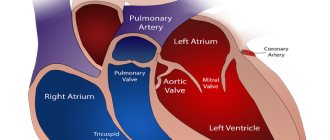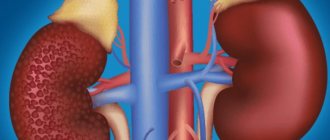Consultation with a cardiologist – RUB 1,750.
- Symptoms
- Diagnostics
- Treatment
Heart failure - this term refers to a violation of the pumping function of the heart, which can occur in both acute and chronic forms. As a result, the normal blood supply to the organs and tissues of the body is disrupted. When the pumping function is disrupted, the heart cannot fully pump blood, which creates a deficiency of oxygen and nutrients. This pathology affects a significant number of people in the older age category.
Causes of heart failure:
- damage to heart tissue - these include myocardial infarction, cardiomyopathy, myocarditis, rheumatism;
- excessive load on the heart muscle - occurs with arterial hypertension, pathology of the heart valve apparatus;
- exposure to toxic substances.
NYHA classification
In
Russian practice it is used together with the above. In addition to dividing into stages, functional classes of chronic heart failure are distinguished based on exercise tolerance:
- FC I - the patient has no restrictions on physical activity. Habitual loads do not cause pathological symptoms (weakness, shortness of breath, pressing pain, palpitations);
- FC II - load limitation is assessed as “moderate”. There are no signs of pathology at rest, but performing normal physical activity becomes impossible due to palpitations, shortness of breath, anginal pain, and a feeling of lightheadedness;
- FC III - “pronounced” limitation of exercise, symptoms are relieved only with rest, and performing even less physical activity than usual provokes the appearance of clinical signs of the disease (weakness, angina, shortness of breath, interruptions in heart function);
- FC IV - inability to tolerate even the slightest (everyday) physical activity, that is, intolerance to it. Discomfort and pathological symptoms are caused by activities such as washing, shaving, etc. Also, signs of heart failure or pressing chest pain can occur at rest.
These two classifications relate to each other as follows:
- CHF stage I - NYHA functional class 1
- CHF stage II A - NYHA functional class 2–3
- CHF II B - Stage III - NYHA FC 4
Reasons for development
Chronic heart failure occurs against the background of other diseases that affect the myocardium and blood vessels. Therefore, it is always necessary to treat or keep primary diseases under medical supervision, as well as monitor the condition of your circulatory system.
Factors in the development of CHF
- Arterial hypertension (AH) is the main cause of chronic heart failure.
- Coronary heart disease (CHD) is in second place among the provoking factors.
- Cardiomyopathies (including those provoked by infectious diseases, diabetes mellitus, hypokalemia, etc.).
- Valvular (mitral, aortic, tricuspid, pulmonary) and congenital heart defects.
- Arrhythmias (tachyarrhythmias, bradyarrhythmias).
- Diseases of the pericardium and endocardium.
- Conduction disturbances (antrioventricular block).
- High load (for example, with anemia).
- Volume overload (eg, renal failure).
The course of any disease from the list above should be monitored by the attending physician
Classification of heart failure
Classification of heart failure is carried out according to clinical signs, namely the ability to adequately tolerate physical activity and the symptoms that arise during this.
The classification made it possible to have a unified approach to diagnosis, as well as, more importantly, treatment of this condition. The first classification dates back to 1935, its authors were Soviet cardiologists N.D. Strazhesko and V.Kh. Vasilenko. For a long time it remained the only one, but in 1964 the NYHA (New York Heart Association) classification was adopted in New York. Cardiologists determined the functional classes of CHF on it.
Diagnostics
If you have symptoms of heart failure and high blood pressure, it is important to consult a physician or cardiologist as soon as possible. The earliest signs are shortness of breath on exertion and decreased exercise tolerance.
To make a diagnosis of CHF, a specialist will specify:
- Typical complaints are shortness of breath, increased fatigue, swelling of the legs, palpitations at rest and during moderate physical activity.
- History: duration of hypertension, coronary artery disease, previous heart attacks, myocarditis and other heart diseases, presence of respiratory pathology.
- Objective signs: an increase in heart size, heart rate and respiratory movements, blood pressure, heart rhythm disturbances, the presence of edema and enlargement of the liver, wheezing in the lungs, pathological tones in the heart.
To confirm systolic or diastolic dysfunction, doctors prescribe laboratory and instrumental diagnostic methods:
- Blood test for natriuretic peptides. These are biological markers of CHF. Needed to monitor treatment. Normal levels of natriuretic peptides in untreated patients virtually exclude cardiac damage.
- All patients with suspected HF undergo a clinical blood test with platelet count, determination of blood sugar and glycated hemoglobin (determines the average blood sugar value over the last 3 months), a general urine test, blood creatinine, glomerular filtration rate, liver function indicators (bilirubin, AST , ALT, alkaline phosphatase, GGT), study of lipid profile (cholesterol, triglycerides, lipoproteins), blood sodium and potassium, total protein, thyroid hormones (TSH, T3 and T4), blood transferrin (for the diagnosis of hidden anemia).
- Echocardiography is an ultrasound method for diagnosing the heart, which allows you to determine the thickness of the myocardium and the volume of the chambers of the heart, the characteristics of all valves, the condition of the interatrial septum, pressure in the pulmonary artery, myocardial contractility with determination of the ventricular ejection fraction.
- ECG (electrocardiogram) is a study of the electrical potentials of the heart in 12 leads. At the same time, the heart rate, the correctness of the rhythm, the presence of cardiac conduction disorders in the form of blockades, myocardial ischemia, left ventricular hypertrophy, fresh and scar changes in heart attacks are assessed. With a normal ECG, the diagnosis of CHF is unlikely.
- Chest X-ray. Needed to detect an increase in heart size (cardiomegaly) and possible pathology of the bronchopulmonary system.
- Coronary angiography is a radiopaque examination of the coronary arteries that supply the heart muscle. Performed for heart failure or angina pectoris that do not respond to drug therapy. Helps determine the degree of coronary artery stenosis for the need for further surgical interventions.
- MRI of the heart and great vessels. It is carried out in complex diagnostic cases when echocardiography is not informative enough. A special role of MRI belongs to the diagnosis of cardiomyopathies and complex heart defects.
When should I make an appointment with a doctor?
Symptoms that occur with heart failure may vary.
Some of them are dangerous and require calling an ambulance, others are a reason for another visit to the doctor or an initial visit to an outpatient appointment. An ambulance should be called if:
- severe and prolonged shortness of breath;
- persistent chest pain that does not go away after taking nitroglycerin;
- hypertensive crisis that cannot be corrected with pills;
- fainting.
You should make an appointment with your doctor if you have symptoms such as:
- shortness of breath and cough at night, the need for additional pillows for a comfortable sleep;
- increased shortness of breath and deterioration of exercise tolerance;
- the appearance of interruptions in the activity of the heart, increased heart rate (more than 90 per minute), the appearance of bradycardia;
- increase in edema of the lower extremities;
- rapid weight gain (2 or more kilograms in 3 days);
- increasing fatigue and weakness;
- an increase in cough, the appearance of concomitant ARVI.
Strazhesko-Vasilenko classification (with the participation of G. F. Lang)
Was
adopted at the XII Congress of Therapists of the USSR. Classification of CHF is carried out in 3 stages:
- Stage I - initial. It is characterized by the fact that hemodynamic disorders are compensated and are detected only with significant physical activity (domestic) or stress tests - treadmill, Master's test, bicycle ergometry (during diagnosis).
Clinical manifestations: shortness of breath, palpitations, fatigue at rest disappear;
- Stage II - severe heart failure. When it occurs, hemodynamics are disrupted (stagnation of blood in the circulatory system), the ability to work is sharply impaired, tissues and organs do not receive the required amount of oxygen. Symptoms occur at rest. It is divided into 2 periods - IIA and IIB. The difference between them: at stage A there is failure of either the left or right parts of the heart, when at stage B there is total heart failure - biventricular;
Stage IIA - characterized by stagnation in the pulmonary or systemic circulation.
At this stage of heart failure, in the first case, left ventricular failure occurs. It has the following clinical manifestations: complaints of shortness of breath, cough with the release of “rusty” sputum, suffocation (usually at night) as a manifestation of the so-called cardiac asthma.
When examining, pay attention to pallor, cyanosis of the extremities, tip of the nose, lips (acrocyanosis). There is no swelling. The liver is not enlarged. On auscultation, you can hear dry rales; with severe congestion, signs of pulmonary edema (fine-bubble rales).
When cardiac function is impaired with the development of stagnation of the systemic circulation, patients complain of heaviness in the right hypochondrium, thirst, swelling, abdominal distension, and indigestion.
There is cyanosis of the face, swelling of the veins of the neck, external edema (later - cavitary edema: ascites, hydrothorax), enlarged liver, heart rhythm disturbances. Treatment at this stage may be especially effective.
- How long can you live with stage 1 chronic heart failure?
Stage IIB - represents total heart failure with severe manifestations of circulatory failure. Combines symptoms of blood stasis BCC and MCC. This stage is very rarely reversible.
Stage III - final stage, heart failure in the decompensation stage. Deep myocardial degeneration occurs, irreversibly damaging both the heart itself and the organs experiencing ischemia and oxygen starvation due to its dysfunction. It is terminal and never undergoes regression.
CHF according to Vasilenko-Strazhesko (stages 1, 2, 3)
The classification was adopted in 1935 and is still used today with some clarifications and additions. Based on the clinical manifestations of the disease during CHF, three stages are distinguished:
- I. Latent circulatory failure without concomitant hemodynamic disorders. Symptoms of hypoxia appear with unusual or prolonged physical activity. Possible shortness of breath, severe fatigue, tachycardia. There are two periods, A and B. Stage Ia is a preclinical variant of the course, in which cardiac dysfunction has almost no effect on the patient’s well-being. Instrumental examination reveals an increase in ejection fraction during physical activity. At stage 1b (latent CHF), circulatory failure manifests itself during physical activity and goes away at rest.
- II. In one or both circles of blood circulation, stagnation is expressed that does not go away at rest. Period A (stage 2a, clinically pronounced CHF) is characterized by symptoms of blood stagnation in one of the blood circulation.
- III. The final stage of the disease with signs of failure of both ventricles. Against the background of venous stagnation, severe hypoxia of organs and tissues appears in both circulation circles. Multiple organ failure and severe swelling develop, including ascites and hydrothorax. Stage 3a is treatable; with adequate complex therapy for CHF, partial restoration of the functions of the affected organs, stabilization of blood circulation and partial elimination of congestion are possible. Stage IIIb is characterized by irreversible changes in metabolism in the affected tissues, accompanied by structural and functional disorders.
The use of modern drugs and aggressive treatment methods quite often eliminates the symptoms of CHF corresponding to stage 2b to a preclinical state.
Prevention
To prevent the development of heart failure and the worsening of its symptoms, it is important:
- Correctly treat the underlying disease. To do this, antihypertensive and cardiac medications must be taken regularly, strive for blood pressure levels less than 140/90, adequately treat coronary artery disease and heart rhythm disorders, and normalize glucose levels in diabetes mellitus.
- Give up bad habits - smoking, overeating, excess alcohol consumption.
- Learn to control stress.
- Lose excess weight by reducing calorie intake and moderate physical activity. At the same time, it is important not to overload the heart with excessive load. It is better to do dosed walking or swimming, gymnastics or yoga.
- Follow dietary recommendations.
The meaning of CHF classification
Assigning a patient's status to a certain stage of CHF is important for selecting therapy, assessing its results, as well as predicting disease outcomes.
For example, stage I chronic heart failure certainly requires the use of fewer drugs and, conversely, stage III CHF forces the cardiologist to prescribe 4–5 groups of drugs. Assessing the dynamics of the functional class of circulatory failure is important, again, for selecting therapy, following a diet, and prescribing a rational motor regimen. The value of classifying the patient’s status for prognosis can be characterized by the following statistics: annually, 10% of patients die from heart failure in FC 1, approximately 20% in FC 2, about 40% in FC 3, and in FC 4, the annual mortality rate exceeds 65%.
- Diagnosis and treatment of chronic heart failure today









